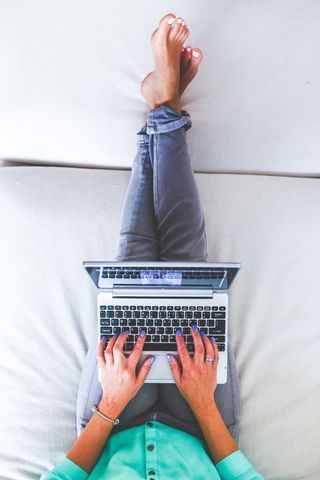Coronavirus Disease 2019
Home Office Syndrome
There's no place like home—unless you’re working from there because of COVID-19.
Posted April 13, 2020 Reviewed by Kaja Perina

“There’s no place like home.”
Dorothy in the "Wizard of Oz" certainly believed it, but many of the millions now required to work from home for seemingly endless weeks because of the COVID-19 pandemic might disagree. In fact, those unable to cope with the upheaval that the virus has caused in their lives may be feeling somewhat stressed, lonely, exhausted, and, perhaps, overwhelmed—symptoms of what psychiatrists and psychologists sometimes refer to as “home office syndrome.”
"Home Office Syndrome"
The syndrome creates significant stress and uneasiness due to a blurring of boundaries between work and home life. An at-home “employee” is oftentimes never really working, never really relaxing—always constantly dividing time between the work assignment that absolutely has to get completed, frequent interruptions from spouse and children, a dog that needs walking, and the house-repair issue that suddenly arises.
Blame some of the at-home angst on a person’s:
- Difficulty establishing a reasonable work-from-home structure and schedule, with designated time periods for work, for family, and for relaxation.
- Lack of routine, resulting in extended at-home working hours that meld too easily with personal time.
Adding to the stress of home office syndrome are the unique economic and social isolation challenges posed by the current viral pandemic, including:
- General uncertainty about the ultimate impact of COVID-19 on personal and family health, income, and short-term plans.
- Feelings of loneliness fostered by government-ordered stay-at-home confinement and loss of social connection with colleagues at the office or with friends and other family members.
On this last point, one, indeed, maybe the loneliest number.
At a recent press briefing on COVID-19, the World Health Organization advised that social distancing and isolation at home posed a challenge globally to mental health and psychological well-being. And authors of a study in Perspectives on Psychological Science found that “actual and perceived social isolation,” is linked to an increased risk of early death.
Julianne Holt-Lunstad, Ph.D., a psychologist at Brigham Young University, says the long-term isolation imposed by COVID-19 is ushering in a “social recession” that threatens physical and mental health. Yale University psychologists are even offering a free online course to teach “better habits” for preserving “happiness” during the pandemic.
But one does not necessarily have to study happiness to attain it. Various tried-and-true coping mechanisms are available to avoid home office syndrome and achieve “psychological well-being.” Psychological well-being is a state of feeling happy, healthy, and physically fit and enjoying a sense of achievement, life-work balance, self-esteem, and strong relationships with others—even when confined and working solo from home.
The First Step to Avoiding Home Office Syndrome
A key first step to this well-being, the antithesis of home office syndrome, is attention to physiological necessities—namely, setting aside time to eat nutritiously (not just snack); sleep sufficiently, preferably seven-to-eight hours; and exercise daily. Way back in 1943, psychologist Abraham Maslow created a model defining a hierarchy of human needs—with food, water, shelter, sleep, and safety being the most basic. Until these basics are met, Maslow said, an individual cannot achieve self-actualization—finding true meaning in work and life.
Eating, sleeping, and exercise also help establish boundaries, neatly dividing the day into “phases” between work time and home life. Without these “phases,” the at-home worker is more apt to skip essentials because of unrealistic work expectations, excessive focus, and obsession with job performance. Exercise has the added benefit of being a great stress-reliever and a counterbalance to long, sedentary hours working from a chair in front of the home computer.
Create a Work Routine
"Are Home Offices Fueling a Mental Health Crisis?" That was the headline of a 2019 Forbes magazine article, in which the writer states that blurring of boundaries between work life and personal life is a primary reason why working from home can exacerbate stress and anxiety. When one’s office is the home, it becomes challenging to “unplug,” to call it a day, to let go. The temptation is to keep going back to the computer to finish one more assignment, check the last box, answer one more email.
In a 2019 State of Remote Work report prepared by Buffer, a global software company, nearly a quarter of surveyed remote employees—most of them working from home—said they had a difficult time unplugging from work; 19 percent professed feelings of loneliness; eight percent experienced lack of motivation.
Those who successfully work from home—without evidence of home-office-syndrome symptoms—have learned to:
- Separate their work area from personal and family space in the home.
- Develop a routine much like the one they had at the office—arising at the same time, starting work at the same time, and concluding at the same time to allow for end-of-day relaxation and interaction with family.
- Consider mornings as an effective time to begin work. Some successful CEOs will even wake early, avoid checking the news or email, and go straight to the “home office.” This kind of schedule can jump-start one’s day, keeping the mind free of other people's queries and demands and enhancing focus on what needs to be done, now.
- Stop answering work-related calls, texts, and emails at day’s end.
- Dress for the office, even though at home.
- Contact colleagues—and friends—on occasion just to check-in, catch up, and stay connected.
It’s Up to You
Remember: at home, you control your day. Set a reasonable work schedule; build in time for necessities, chores, family, and yourself; establish achievable goals; make the effort to stay connected; and stop wringing your hands. COVID-19 will eventually run its course. And then, perhaps, we can all return to normal.
LinkedIn Image Credit: weedezign/Shutterstock




